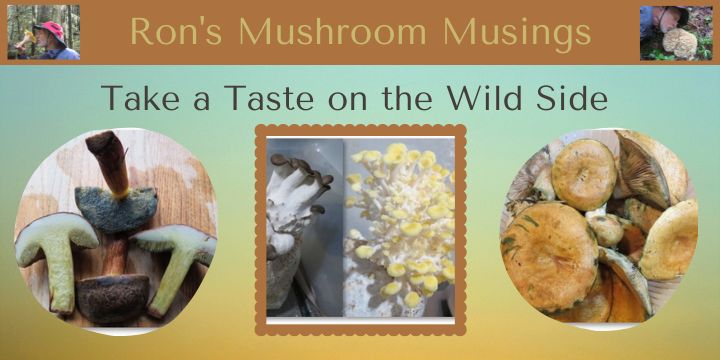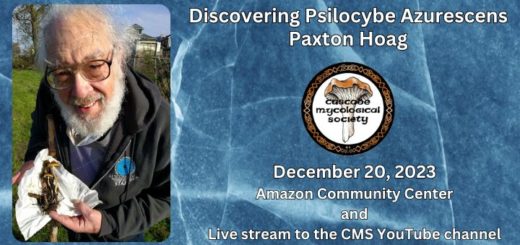Take a Taste on the Wild Side

Sandy and I have been out mushrooming several times this fall and each time we’ve only found a few chanterelles. Even though we had good rain in September and October, chanterelles have been shy growers so far this fall. The ones we did find were in perfect condition with no signs of any old, water-logged chanterelles in the area. Others we’ve spoken with have observed the same low chanterelle fruiting we’ve been experiencing. This could mean that chanterelles are just starting late this year or they’ve decided to take a well needed break and just pop up a few now and then. On the other hand, it was a very good fall for bolete lovers. We still have half a dozen mason jars filled with dried boletes so we just picked what we could sauté and eat. Our primary focus was once again on the lesser picked edible species Oregon has to offer.

The first mushroom we selected was the Red-Bleeding Milk Cap (Lactarius rubrilacteus), which is a relatively easy mushroom to identify. As the common name implies, if you slice off a small piece of its cap, it will exude a red milky liquid. If the liquid is any other color, changes color, or has no liquid at all, you have most likely found something else. In past years we’ve left this mushroom alone as fungal gnat larvae seemed to be hosting parties in most of them. This fall they were in large abundance and as clean as a colon prepped for a colonoscopy. One key to experiencing a mushrooms true flavor is to sauté them as soon after picking them as possible. Allowing them to age in your refrigerator or collecting basket can negatively affect their texture and flavor. It can also give currently unseen larvae a chance to become seen larvae. Not that there are any in your mushroom collection, but why take that chance. We wasted no time getting this batch sliced up and into the sauté pan. When sautéing, the Red-Bleeding Milk Cap will initially exude a red liquid into the pan, which will eventually evaporate off. Although, if you’re really big into that whole vampire craze, you can always pore off the liquid and make a nice red rice dish with it. For a first-time taste test, we only use unsalted butter when sautéing them and cook them until they had a nice golden-brown hue. Undercooked mushrooms can have a slimy mouth feel and less appealing flavor. Although, if you love slurping cold, slimy, raw oysters, undercooked mushrooms might just be your thing. For us, the flavor and texture of the Red-Bleeding Milk Cap was very good. We will harvest it again and experiment with different mushroom recipes to add it to.

Our second new to the table mushroom was the Cracked-Cap Bolete (Xerocomellus diffractus). In older mushroom books you’ll find this mushroom listed as Boletus Chrysenteron. It is an attractive mushroom and can often be found in great abundance soon after our fall rainy season starts. According to the Website withmalustowardnone, the species name diffractus means; broken or separated by narrow cracks. The cracked cap attribute is very helpful in identify this mushroom when you encounter it on a mushroom hunt. The stem will display different degrees of red color as the mushroom ages with yellow banding just under its cap. As other mushrooms in the genus Xerocomellus can have similar color and/or cracked cap patterns, it’s possible to make a mistake in identifying what you found. Fortunately, according to the Santa Cruz Mycoflora Project website, mushrooms in Xerocomellus are “all thought to be edible”, at least for our area. However, they also state that flavor profiles of these mushrooms will vary between species. As for the Cracked-Cap Bolete, we also enjoyed its flavor and texture. Although, before cooking we did remove the sponge layer (pores/tubes) under the cap as these can become slimy when cooked.

At this year’s Mount Pisgah Arboretum Mushroom Festival, I had a chance to run down to the Rainforest Mushroom booth and snatch up a couple of mushroom kits. I picked the black king oyster and yellow oyster kits to fruit at home. I placed them in a transparent storage container on blocks with wetted newspaper (to maintain humidity) placed underneath them. The container lid was put on in a way to allow plenty of air circulation into the container. The garage temperature was perfect for the black king oyster but a little on the cool side for the yellow oyster. As a result, the black king oyster fruited like crazy but the yellow oyster only set a single cluster. I guess it wanted me to know it wasn’t a happy camper. In any event, they were all sliced up and oven roasted in a Pyrex dish. I’m thinking they will most likely wind up in a rice dish with broccoli, sliced peppers, and onions. And NO, I didn’t save the red liquid from the Red-Bleeding Milk Caps to make the rice red.
I hope November is going well for you and that you’ll get a chance to hit the woods to refresh your sole and possibly find a few nice edible mushrooms. Ron





